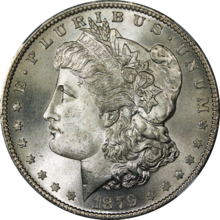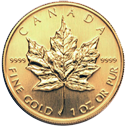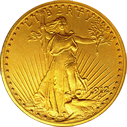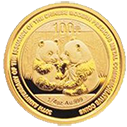Silver Morgan
The Morgan dollar was a United States dollar coin minted from 1878 to 1904, and again in 1921. It was the first standard silver dollar minted since production of the previous design, the Seated Liberty dollar, ceased due to the passage of the Coinage Act of 1873, which also ended the free coining of silver. The coin is named after its designer, United States Mint Assistant Engraver George T. Morgan. The obverse depicts a profile portrait representing Liberty, while the reverse depicts an eagle with wings outstretched.

The dollar was authorized by the Bland–Allison Act. Following the passage of the 1873 act, mining interests lobbied to restore free silver, which would require the Mint to accept all silver presented to it and return it, struck into coin. Instead, the Bland–Allison Act was passed, which required the Treasury to purchase between two and four million dollars’ worth of silver at market value to be coined into dollars each month. In 1890, the Bland–Allison Act was repealed by the Sherman Silver Purchase Act, which required the Treasury to purchase 4,500,000 troy ounces (140,000 kg) of silver each month, but only required further silver dollar production for one year. This act, once again, was repealed in 1893.
In 1898, Congress approved a bill that required all remaining bullion purchased under the Sherman Silver Purchase Act to be coined into silver dollars. When those silver reserves were depleted in 1904, the Mint ceased to strike the Morgan dollar. The Pittman Act, passed in 1918, authorized the melting and recoining of millions of silver dollars. Pursuant to the act, Morgan dollars resumed mintage for one year in 1921. The design was replaced by the Peace dollar later the same year.
In the early 1960s, a large quantity of uncirculated Morgan dollars in their original bags were discovered in the Treasury vaults, including issues once thought rare. Individuals began purchasing large quantities of the pieces at face value, and eventually the Treasury ceased exchanging silver certificates for silver coin. Beginning in the 1970s, the Treasury conducted a sale of silver dollars minted at the Carson City Mint through the General Services Administration. In 2006, Morgan’s reverse design was used on a silver dollar issued to commemorate the old San Francisco Mint building.
Featured Products
Client Testimonials
Hope Ludeke
, Sacramento,
I want to thank American Gold Metals for the excellent service they provide in my acquisition of precious metals. I find the website to be informative with easy navigation. The experts demonstrate an impeccable knowledge base and excellent service along with care and genuine concern for the client. As they educate me on the rationale and logistics of investing in precious metals, the information is always very palatable. In other words, they make the learning curve seem effortless. I have no hesitation in referring friends and colleagues to American Gold Metals and look forward to working with them for many years to come because they’ve proven themselves to be trustworthy, timely and very professional.
Sandra D
Martha W
The folks at American Gold Metals are knowledgeable and patient. They took the time to answer all of my questions and to explain how the process of owning precious metals worked. As someone that knew nothing about precious metals, I am eternally thankful for their continuing support.
Suzan J
, Studio City,
I recently added silver to my portfolio and I found the specialist I worked with to be very professional. His understanding and knowledge of the precious metals market and the forces that drives it, was very impressive and made sense to me.
Request this Comprehensive 12 Page Metals Guide
and Protect Your Retirement Today!
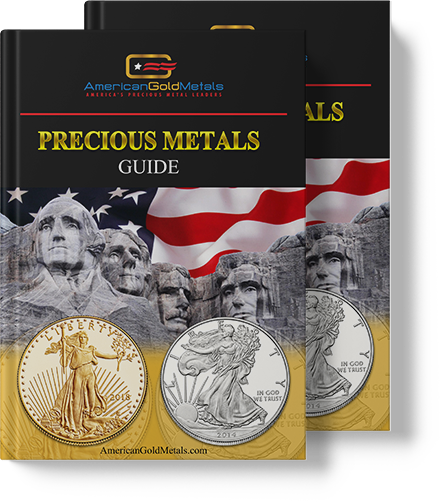
Inside you’ll learn:
- Why Rollover to a Gold & Silver IRA
- Advantages of Physical Possession
- Strategic Investment Options
Request Your FREE Metals Guide
Understand the ADVANTAGES of adding Precious Metals to your IRA
Complete the form…







